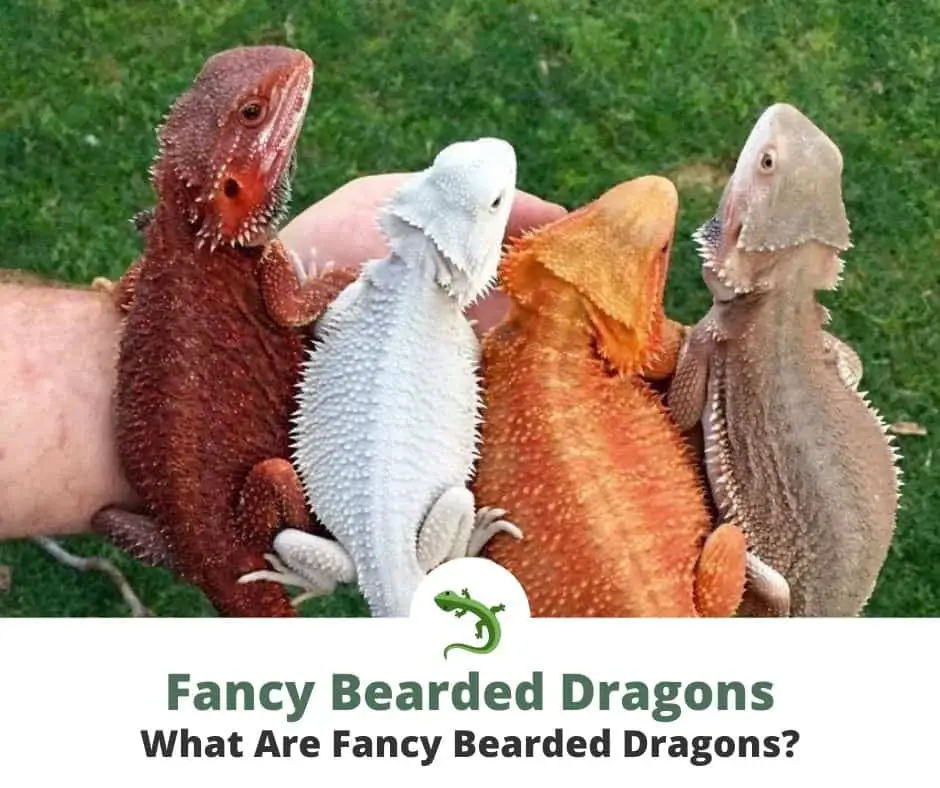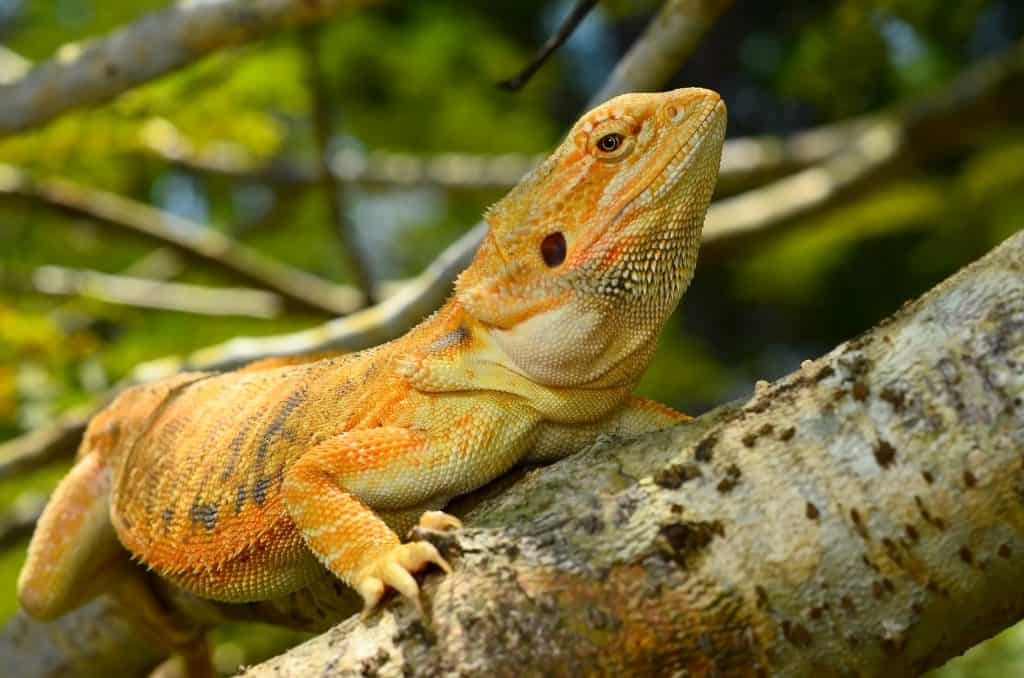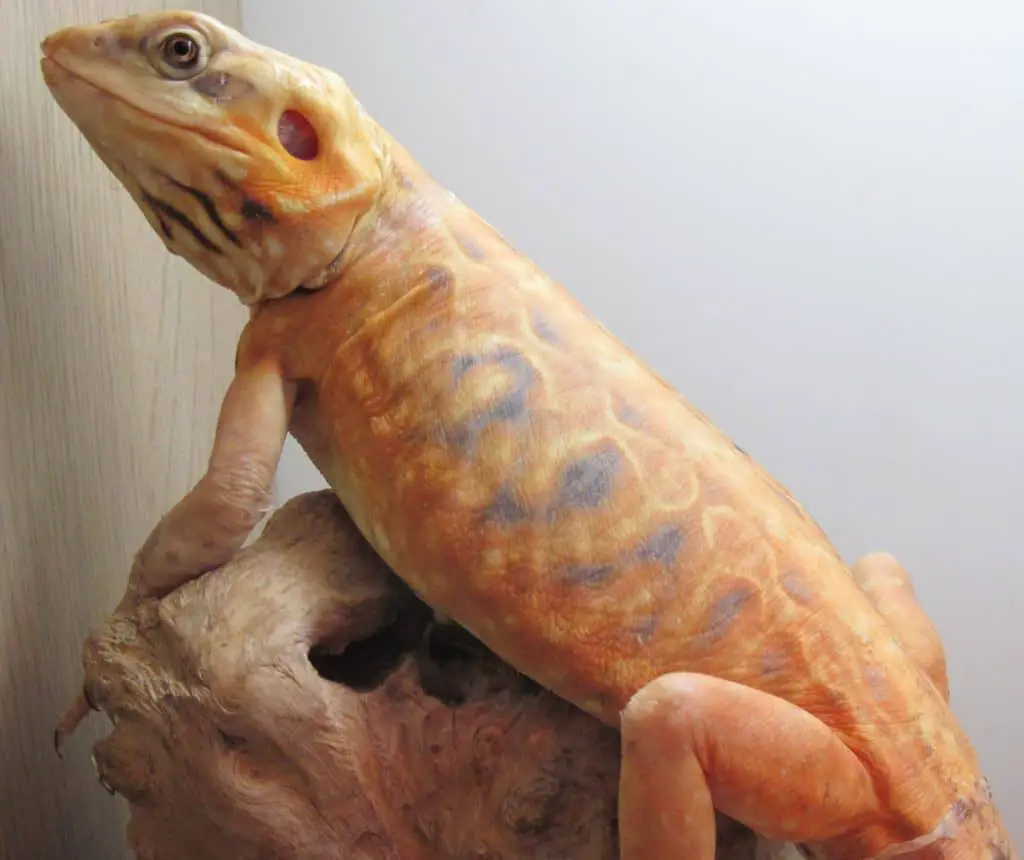If you’re looking to purchase a bearded dragon as a pet then you have probably encountered the term “fancy bearded dragon.” Find out what they are in the guide below.
In this guide, you’ll learn:
- What are fancy bearded dragons?
- How do they differ from morphs?
- Do fancy bearded dragons make good pets?

Bearded dragons are known for their spiky scales along their flanks and a beard that puffs up depending on their mood giving them their name. Because of their popularity as pets, different morphs or varieties, often labeled as “fancy” are available in the market. They are reptiles native to the warm, arid deserts and woodlands of Australia. They are omnivores whose diets consist of insects and plant matter.
What Is A Fancy Bearded Dragon?
A fancy bearded dragon is a variation of the standard bearded dragon commonly kept as pets with different, unique, and visually pleasing physical characteristics. These differences are usually caused by mutations in their genes. These traits are expressed in subsequent generations through selective breeding though some fancy bearded dragons may just be unexpected offspring with unique traits.
Clarification
The term fancy bearded dragon is also used to describe different bearded dragon morphs. Some breeders, sites, and forums may use the term interchangeably. A beardie that is a different bearded dragon morph from the standard may be named a “fancy bearded dragon.” A more technical description of a “fancy bearded dragon” is a bearded dragon whose unique trait cannot be traced to a specific standard morph or genetic mutation. It can also be used to describe a bearded dragon with traits different from the standard but whose exact morph cannot be identified.
📚 Read More >> Bearded Dragon Morphs
Bearded Dragon Morphs
A morph is a term used to describe a bearded dragon’s overall appearance such as its body type, scales (or lack of), and size. The terminology also applies to other lizards and reptiles such as ball pythons and iguanas.
Different bearded dragon morphs arose due to the artificial selection or selective breeding of bearded dragons with desirable traits or characteristics. Two individuals from different clutches with favorable traits are bred with each other to increase the chances of the next generation demonstrating that trait and so on.
Fancy Bearded Dragon vs. Standard Bearded Dragon: How Do They Compare?
How Are They Similar?
Fancy bearded dragons and standard bearded dragons are of the same species, Pogona vitticeps or the Central Bearded Dragon commonly found in captivity. They usually have the same basic look, behavior, and grow to a similar size (except for the German Giant).
How Are They Different?
Fancy dragons may have a different color, skin melanin content, pattern, or degree of scalation from the standard bearded dragon. As such, they may also have different care requirements such as softer UV lighting or special creams for moisturization.
4 Types Of Fancy Bearded Dragons
The list below is grouped into fancy bearded dragons that have similar traits which differ from the standard look of a classic bearded. Again, the descriptions or names of these fancy bearded dragons also refer to bearded dragon morphs.
1. Fancy bearded dragons that differ via scalation
There are fancy bearded dragons that differ in the absence or presence of scales and spikes on their bodies making their skin texture different. These include Leatherback bearded dragons, Silkies, Microscale, and Dunner.
📚 Read More >> Silkback Bearded Dragons
Leatherback bearded dragons have more vivid colors on their backs due to the missing ridge of spikes or scales along their back. The absence of these spikes also makes their skin feel a bit smoother.

Silkback bearded dragons or silkies have absolutely no scales making their skin colors look more vivid and feel smoother. They do, however, need special care because of this trait, and breeding them has become ethically questionable.

Microscale bearded dragons have even fewer scales than Leatherbacks. They lack or have smaller and fewer spikes on their beards and flanks. They can also have smoother scales.
Dunner bearded dragons have spikes that are oriented in a different way than classic bearded dragons. Their spikes are usually oriented sideways or downwards.
2. Fancy bearded dragons that differ via the melanin content of their skin
The general term for bearded dragons that have lower melanin content is leucistic. These bearded dragons have paler or muted colors, some are even white. The nails of these dragons can also be white or transparent.
Hypomelanistic bearded dragons have very little to no melanin content making their skin color very light, almost pale. This genetic mutation can affect other morphs of bearded dragons (e.g. hypo-leatherbacks).
Translucent bearded dragons also have low melanin content and have very thin, semi-transparent skins, especially on their bellies and flanks, giving a bluish tinge due to the black membrane underneath.
Zero, Witblits, Wero, and Silverback bearded dragons appear greyish or even white due to their lack of melanin. They can also have very pale or muted colors.
3. Fancy bearded dragons that differ in size
German Giant bearded dragons are the only known morph that affects size and can grow up to 25-30 inches. However, it’s very hard to identify a German Giant unless it’s done growing.
4. Fancy bearded dragons that differ via color or pattern
Dunner, Genetic Stripe, and Paradox bearded dragons differ in their patterns. Dunner morphs, aside from their disorganized scalation, have spots or blotches because of their discontinued markings (classics closely resemble stripes instead of spots).
The Genetic Stripe has a distinct stripe along their backs at each side of the spine.
Paradox bearded dragons have a solid base color (usually grey or off-white) that develops random patterns or patches in a different color. These are very rare and expensive.
Different colors can affect different bearded dragon morphs and the use of colors to describe bearded dragons are often subjective. The red color is usually rare. Orange, citrus, and yellow bearded dragons can be a bit more common. Blue, violet, or purple bearded dragons are extremely rare and are just Translucent bearded dragon morphs that retain the bluish color into adulthood.
Patterns such as tiger, paradox, or spots can also be characteristics of a fancy bearded dragon.
Do Fancy Bearded Dragons Make Good Pets?
Yes, fancy bearded dragons are ultimately just like standard bearded dragons except for the varieties that affect scalation and melanin content of skin that require special care.
They only differ in their physical traits and should have the same disposition as classic bearded dragons – docile, calm, and even affectionate. They should, therefore, make good pets.
Important Note
Fancy bearded dragons or certain bearded dragon morphs (those with fewer scales and melanin content especially silkbacks) need special care to ensure that they are still healthy. Make sure you do enough research so you can prepare to provide the appropriate care for your beardie.
Where Can You Buy A Fancy Bearded Dragon?
Fancy bearded dragons (or different bearded dragon morphs) are best bought from responsible and experienced breeders to ensure that they are still of good genetic stock. Your local veterinarian might know some and there are forums or groups online that you can consult to check out local breeders. Large chain pet stores often only have classic bearded dragon morphs for sale.
Pro-Tip ⚡
Do your research about unique types of bearded dragons (be it morphs or fancy) and where you can find a responsible breeder to buy them from. The term “fancy bearded dragon” is often used by large chain pet stores or dishonest breeders to justify a steeper price tag and you may not be getting what you pay for.
Conclusion
Fancy bearded dragons are the same species as standard bearded dragons with one or two physical traits that are different, usually the scalation, color, or pattern. The term should not be confused with different bearded dragon morphs. A beardie that is of a different bearded dragon morph from the standard may be named a “fancy bearded dragon.”
Some varieties of bearded dragons labeled as fancy may have specific care requirements in terms of lighting and skin moisturization.
FAQs
Do fancy bearded dragons like to be held?
Yes, to a certain extent. They are just like normal bearded dragons that should be trained to tolerate handling. However, other varieties such as the silkback bearded dragons may be prone to injuries while handling so it’s best to keep it at a minimum.
Are fancy bearded dragons aggressive?
No, only German Giants are slightly more aggressive than the standard bearded dragon morphs. The rest should have the same temperament as the standard bearded dragon.
Do fancy bearded dragons grow slower?
No, fancy bearded dragons are the same species as standard bearded dragons that have slightly different physical traits. They should grow at the same rate as normal beardies and have the same basic care requirements (except for fancies that differ in terms of scalation and melanin content).
Further Reading
Overview on Bearded Dragons:
Bearded dragons: facts and photos
Short but informative manual on bearded dragon care (written by a vet):
Caring for the Bearded Dragon
A full and exhaustive guide to bearded dragons from taxonomy, history, behavior, breeding, and many more:
Husbandry Manual For Bearded Dragons. Reptilia: Agamidae
A study on bearded dragons with fewer scales:
Bearded dragons (Pogona vitticeps) with reduced scalation lose water faster but do not have substantially different thermal preferences | Journal of Experimental Biology
A Quick Guide to the essential needs of a bearded dragon:
Bearded Dragon Husbandry and Preventative Healthcare


